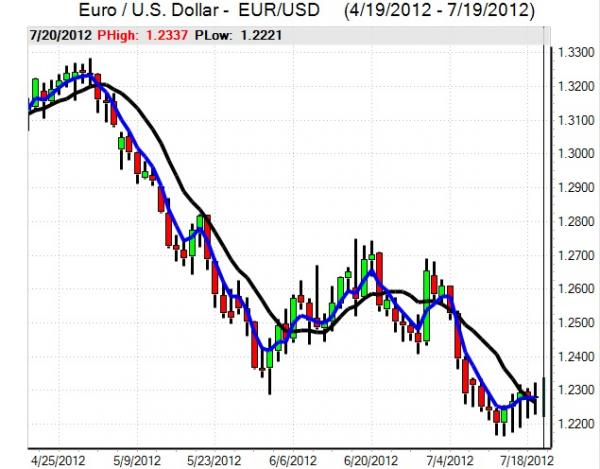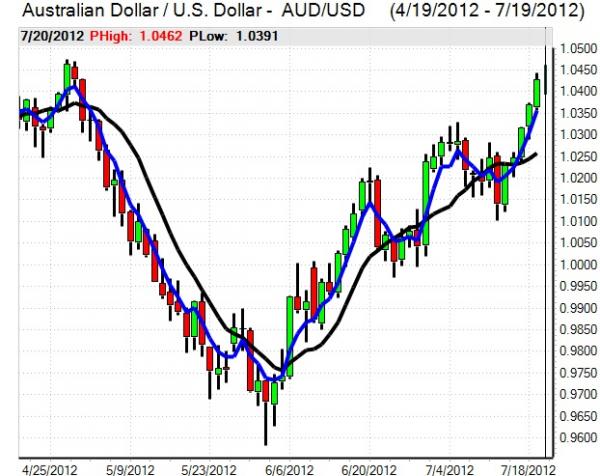EUR/USD
The Euro was again frustrated in its attempt to sustain a move above 1.23 against the dollar on Thursday with persistent weakness on the crosses an important element in curbing any advances.
Spain continued to be an important focus during the day as underlying fears increased. There were sharply higher yields in the latest bond auctions and there was also a sharp decline in the bid/cover ratios which suggested particularly weak investor demand. Benchmark Spanish bond yields moved above the 7.0% level which was important in undermining confidence with fears that Spain was sliding deeper towards requiring a sovereign bailout which would trigger further major stresses within the Euro area.
The Euro rallied on reports that the EFSF might be able to buy Spanish bonds if there were spare resources from the rescue package, but this was later denied by the European Commission with the Eurogroup set to meet to finalise the bailout package on Friday. A successful outcome would provide some temporary relief for the currency.
The US economic data was significantly weaker than expected during Thursday. Initial jobless claims increased to 386,000 in the latest week from 352,000, although the underlying trend may well have been little changed. Existing home sales fell to 4.37mn from 4.62mn previously which dampened confidence in the housing sector. The Philadelphia Fed manufacturing index did register a monthly improvement, but it was still weaker than expected for the fourth consecutive week and negative throughout the past quarter.
There was a deterioration in risk appetite following the data and there was also inevitably fresh speculation that the Federal Reserve would move to additional quantitative easing which curbed dollar demand.
The Euro secured a brief boost as the German Bundestag approved the Spanish bailout, but the currency was again unable to sustain a move above the 1.23 level and retreated back to the 1.2250 area on Friday as underlying Euro weakness persisted.

Source: VantagePoint Intermarket Analysis Software
Call now and you will be provided with FREE recent forecasts
that are up to 86% accurate* 800-732-5407
If you would rather have the recent forecasts sent to you, please go here
Yen
The dollar struggled to gain any significant traction against the yen during Thursday and briefly dipped to test support below 78.50. There was evidence of semi-official bidding below this level which helped trigger a small-scale recovery.
The yen continued to gain underlying support from weaker than expected US economic data and by continuing safe-haven demand as Euro-zone fears intensified. Ranges were relatively narrow, especially as there were still important reservations surrounding the threat of Ministry of Finance intervention to restrain the yen. The dollar consolidated just above 78.50 in Asia on Friday with the Euro edging towards the 96 level.
Sterling
Sterling initially hit selling pressure near 1.57 against the dollar and dipped weaker following the latest economic data. The retail sales data was weaker than expected with a 0.1% monthly gain for June following a revised 1.5% gain the previous month.
The data reinforced doubts surrounding the growth outlook, especially after a generally downbeat IMF report. Sterling, however, regained ground quickly and pushed to highs above 1.57 as Euro weakness on the crosses dominated. Sterling pushed to a fresh 44-month high just beyond the 0.78 level before edging slightly lower.
There was further evidence of safe-haven considerations as demand for non-peripheral European bonds remained extremely strong which continued to have a positive Sterling impact as the Euro remained weak on the crosses. There is likely to be longer-term speculation that Sterling could be subjected to renewed selling pressure.
Swiss franc
The dollar again found support in the 0.9750 region against the franc on Thursday with a move to above 0.9820 before retreating again. The Euro was trapped close to the 1.2010 area as underlying tensions in the Euro-zone area remained extremely high as Spain fears intensified.
The Swiss trade account remained in strong surplus for June and there was a gain in exports for the first time in four months which provided some degree of support. There will still be strong pressure for franc gains to be resisted with further concerns surrounding the threat of deflation.

Source: VantagePoint Intermarket Analysis Software
Call now and you will be provided with FREE recent forecasts
that are up to 86% accurate* 800-732-5407
If you would rather have the recent forecasts sent to you, please go here
Australian dollar
The Australian dollar continued to find strong support during Thursday and pushed steadily to four-month highs near 1.0450 before a limited correction. There was underlying evidence of Australian currency demand from central banks which continued to provide underlying support with further speculation that central banks were diversifying into the Australian dollar.
Regional equity markets were on the defensive during Friday which hampered the Australian currency and it retreated back to the 1.04 area as growth concerns remained an important underlying factor.



